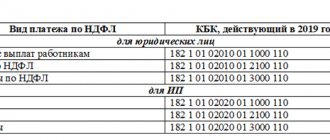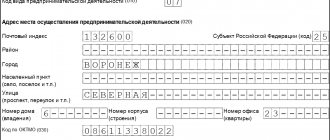Retail space is a concept that anyone running a retail business deals with. According to the definition, the area of the sales floor is considered to be that part of the store territory (pavilion or open trading area) that is occupied by the display of goods, customer service and cash settlements with them, cash registers and cash control units, as well as work areas for service personnel and space for customers to pass through.
Questions related to the area of a retail facility relate to the calculation of UTII and are relevant for those “imputed” workers who are employed in retail trade or catering. The area of the trading floor is the same physical indicator on the basis of which the single tax is calculated. Along with this term, the concepts of a retail space or the area of a retail space are used. Sometimes it can be difficult to determine the status of a retail facility and know exactly which of the mentioned physical indicators should be applied. The necessary instructions can be found in paragraph 3 of Article No. 346.29 of the Tax Code of the Russian Federation. Today we will try to clarify this issue ourselves.
How is retail space calculated?
A physical indicator called the sales floor area is used in the case of sales through the operation of a stationary retail chain facility that has a sales floor measuring less than 150 square meters. m. If there is no trading floor, one of two indicators is used - a retail space (if its area is no more than 5 square meters) or the area of a retail space, if such is more than 5 square meters.
For the correct application of UTII, it is necessary to clarify the question of where retail sales of goods are allowed. The transfer of retail trade to “imputation” is carried out if it is carried out in objects belonging to a stationary retail network. In this case, a retail space is any building (structure or premises) that is intended or used for trading activities. This moment is regulated by Article No. 346.27 of the Tax Code of the Russian Federation. You can find out about the purpose of the premises by looking at the title or inventory document. We are talking about a purchase and sale or lease agreement, a technical passport, as well as plans, explications and diagrams.
At first glance, one might decide that the imputed tax can be charged not only on the area of shopping complexes, but also applied to any premises where trade takes place. For example, to a warehouse or other premises not intended for trade. But according to the clarification of the Ministry of Finance, the sale of goods in such areas initially not intended for trade is not transferred to UTII.
The tax base
The procedure for determining the tax base for UTII depends on the area of retail outlets.
For all retail locations with an area of less than 5 square meters. m, determine the tax base for the quarter using the formula:
| Tax base for UTII for the quarter, calculated by the number of retail locations | = | Basic profitability per month (RUB 9,000) | × | Number of trading places used for purchase and sale transactions in the first month of the quarter | + | Number of trading places used for purchase and sale transactions in the second month of the quarter | + | Number of trading places used for purchase and sale transactions in the third month of the quarter | × | × | K2 |
If during the quarter the number of retail locations increased or decreased, take into account the changes from the beginning of the month in which they occurred (clause 9 of Article 346.29 of the Tax Code of the Russian Federation).
For all retail locations with an area of more than 5 square meters. m, determine the tax base for the quarter using the formula:
| Tax base for UTII for the quarter, calculated by the area of retail outlets | = | Basic profitability per month (RUB 1,800) | × | The area of retail spaces used for purchase and sale transactions in the first month of the quarter | + | The area of retail spaces used for purchase and sale transactions in the second month of the quarter | + | The area of retail spaces used for purchase and sale transactions in the third month of the quarter | × | K1 | × | K2 |
The value of the physical indicator - the area of retail places - is included in the calculation of UTII rounded to whole units (clause 11 of Article 346.29 of the Tax Code of the Russian Federation). Rounding the size of the physical indicator, its values are less than 0.5 square meters. m discard, and 0.5 sq. m or more, round to the nearest whole unit (letter of the Ministry of Finance of Russia dated June 16, 2009 No. 03-11-11/111). In this case, rounding is carried out in relation to the total area of all retail places. Include the area of each retail space in the calculation without rounding (for example, 15.42 sq. m). This follows from the letter of the Ministry of Finance of Russia dated November 15, 2011 No. 03-11-06/3/116.
If during the quarter the area of retail spaces increased or decreased, take into account the changes from the beginning of the month in which they occurred (clause 9 of Article 346.29 of the Tax Code of the Russian Federation).
If during the quarter the organization used retail spaces of various sizes (less than and more than 5 sq. m), then the total tax base for the quarter will be:
| Tax base for UTII for the quarter | = | Tax base for UTII for the quarter, calculated by the number of retail locations | + | Tax base for UTII for the quarter, calculated by the area of retail outlets |
If an organization began or stopped using UTII during the quarter (for example, from February 20), then the tax base must be determined taking into account the actual duration of activities on UTII for the month in which the organization was registered (deregistered) as a single payer tax For more information about this, see How to calculate UTII.
How is the area of a sales area calculated?
The Tax Code states that it should be determined in accordance with title and inventory documents. The situation is exactly the same with regard to the area of the retail space. Tax authorities and entrepreneurs often argue with each other over the discrepancy between the area actually used for trading and that indicated in the documentation.
The courts are of the opinion in this matter that the imputed tax must be calculated on the basis of the actually used square meters of this same retail space. But if such a discrepancy is not confirmed by witness testimony, photographs or existing partitions (as well as other evidence), the court will decide in favor of the tax authorities.
Supermarkets
The trading area of supermarkets is slightly smaller (from 600 to 1000 sq. m) than hypermarkets; accordingly, the assortment is smaller, but all categories of food and household goods are preserved. In supermarkets, as in hypermarkets, the sale of products is carried out on the principle of self-service, the buyer takes a special cart or basket, independently selects the product and pays for it at the cash register. Some supermarkets even have bakery and culinary sections. As in all self-service stores, at supermarkets the flow of incoming and outgoing customers is delimited into separate zones.
Lease agreement: read carefully
Therefore, when leasing premises and using only part of it for trade, make sure that the lease agreement contains clear explanations regarding the actual area being used. The calculation of the imputed tax does not include that part of the trading floor that is leased or subleased. When calculating the area of the sales floor, the so-called auxiliary premises - administrative and household purposes and those used for storing and receiving goods - are not taken into account.
If such premises are physically fenced off from the sales floor, the number of claims in the event of an inspection will immediately decrease by an order of magnitude. If the size of the area changes or its purpose is changed, the manager should document this in order to avoid disagreements with the inspection authorities.
How to choose a premises for a store? Depends on business strategy
Whatever business you are in, before choosing a premises, you must determine your business model - what standard you want to meet and who you want to work for.
The widest possible audience and thousands of product positions? We're talking about a hypermarket - you need a piece of land and a building of about 6,500 sq. m. m. The “Everything at one price” store will fit into 30 square meters - in a one-room apartment, converted into non-residential use, on the ground floor of the “ship house”. Look for a location for a fashion boutique in a shopping center.
First, decide what kind of person you are - and then choose the right room.
If you are targeting an audience that is chasing low prices, then you are a discounter. You don't need cross-country ability, you can have a dirty floor and a tent altogether. Your task is to save on renting premises, cleaning, storage and the cost of goods. If you want to sell goods at a higher price, you will have to choose the premises more pickily.
For retail premises (except discounters), the following conditions are usually characteristic and desirable:
- High ceilings – from 3 m
- Display windows
- Good electrical power – from 10 kW
- If the room is on the 1st floor of a multi-storey building - a separate entrance from the street
- Most of the premises should be a trading room
- Availability of storage and/or utility room
- Bathroom for employees
- If the total area of the room is more than 100 sq. m, an emergency exit is required - a requirement of fire safety standards
Determine who you are, what your business model is - from here the key parameters of the retail space will become clear
How to save money on a showroom
An exhibition hall can also be called a trading hall - if goods are sold directly there. Sometimes the display of goods, payment and actual release are carried out in different premises. In this case, it would be correct to calculate the tax taking into account the total area of the retail premises.
Sometimes a specific entrepreneur (organization) sells goods simultaneously in several premises located in the same building. For example, in a vast area of a shopping center - on different floors or simply apart from each other. Then UTII is calculated separately for each of them.
Let's talk about the area of the retail space
A retail space is not necessarily a huge store. Sales can also be carried out in a small area called a trading place. What is included in the concept of retail space and how to determine it? The Tax Code does not provide clear instructions in this regard. The Ministry of Finance believes that its calculation includes, along with the territory where the direct sale of goods takes place, the sum of all areas of auxiliary premises. For example, in the case of renting a container, partly used for the sale of goods, and partly as a warehouse, the tax is calculated on its entire area.
Thus, in some situations, it is more profitable for entrepreneurs if their sales premises have the status of a trading floor. Then the tax amount can be reduced. Judicial practice contains many examples of disagreements about what is considered a trading floor and what is considered a trading place. In practice, they focus on the presence of a certain space in which buyers have the opportunity to move between shelves with goods and make their choice.
Retail space tax 2021
Video - how individual entrepreneurs and LLCs switch to imputation (step-by-step instructions for filling out an application using the UTII-1 and UTII-2 forms): The deduction through the online cash register is subject to reflection in the UTII declaration. Its structure, therefore, must also be changed legislatively. Video - creating a declaration on UTII in online accounting My business (LINK): Among other notable innovations in the field of legislative regulation of UTII in 2021 is an increase in the duration of application of imputation by a special type of business - consumer cooperatives.
We calculate using the above formula: Since UTII must be paid quarterly, we multiply the resulting amount by 3. As a result, we have 36409.5 - this is how much must be paid to the state budget for one quarter 1800 * 25 * 1.798 * 0, 27 * 0.15 = 3, 276.85 * 3 = 9830.5 rubles Thus, the difference between the first and second calculations is 26,579 rubles.
What's the difference
Such a feature, by definition, cannot be inherent in a retail space, which most often looks like a counter or showcase with goods displayed, directly from which sales are made. The Federal Tax Service believes that if the inventory or title documents of the premises do not contain an indication of the status of a store or pavilion or there is no clear definition of part of the premises as a trading floor, then the mentioned object can by default be considered to belong to a stationary retail chain and not have a trading floor.
Sometimes, in the entire retail space market, objects with a sales floor include exclusively shops or pavilions. That is, in the case of sales in a former warehouse, it is necessary to prove the status of the premises as a trading floor. At the same time, in a container-type pavilion, a trading floor is implied by definition, based on the word “pavilion” alone.
Calculation of UTII
Having determined the size of the tax base, calculate the amount of UTII using the formula:
| UTII = Tax base for UTII for the quarter × 15% |
This follows from subparagraph 10 of paragraph 5.2 of the Procedure, approved by order of the Ministry of Finance of Russia dated January 23, 2012 No. ММВ-7-3/13.
An example of calculating UTII from retail trade through facilities that do not have sales floors. The number of retail locations changed during the tax period
Alpha LLC sells retail through a tent located at the food market and applies UTII.
In 2021, the value of the deflator coefficient K1 is 1.798. The value of the correction factor K2 by local authorities is set at 0.7. The tax rate is 15 percent.
The area of the tent that the organization used until February 8 was 4 square meters. m. From February 10, the area of the tent was increased by one and a half times and amounted to 6 square meters. m. Thus, when calculating the tax base for UTII for the first quarter, the following indicators are used:
- in January – 1 retail space;
- in February – 6 sq. m;
- in March – 6 quarters. m.
Imputed income for calculating UTII for the first quarter was:
- for January: 9000 rub./trade. place × 1 bargain. place × 0.7 × 1.798 = 11,327 rubles;
- for February–March: 1800 rub./sq. m × (6 sq. m + 6 sq. m) × 0.7 × 1.798 = 27,186 rubles;
- total for the first quarter: RUB 11,327. + 27,186 rub. = 38,513 rub.
The amount of UTII for the first quarter is equal to:
RUB 38,513 × 15% = 5777 rub.
The calculated amount of UTII can be reduced by the amount of insurance premiums paid and hospital benefits paid (clause 2 of Article 346.32 of the Tax Code of the Russian Federation). For more information about this, see How to calculate UTII.
Let's understand the concepts
A store is a building or part of it, specially equipped, the purpose of which is to sell goods and provide services to customers. The store must be provided with premises not only for trading, but also for utility, administrative and domestic purposes, as well as those intended for the acceptance, storage of goods and their pre-sale preparation.
Pavilions include a building that has a sales area and provides one or more workplaces.
In the situation of owning a total retail area not exceeding 5 sq. m, disputes over the use of one or another physical indicator are pointless. The basic profitability for tax authorities in the case of sales in a sales area or at a retail location will be exactly the same. To reduce the tax, the area must be less than 5 square meters. m, which, you see, is difficult to consider as a trading floor. When the space exceeds 5 square meters. m, the calculation is based on the area or sales floor, or retail space, the standard profitability figure of which is the same - 1800 rubles. from every square meter.
From this we conclude: in the case of a large retail space, it is more profitable for an entrepreneur to equip it in such a way that part of the area is allocated for a trading floor. After all, as already mentioned, the space remaining for auxiliary premises is not included in the tax calculation.
Results
When applying UTII in retail trade, one of the physical indicators in relation to which the basic profitability of the type of activity being carried out is determined is the area of the premises or place in which trade is carried out. It is important for sales conducted through a stationary retail network (with or without sales floors) or in the absence of a stationary network (at retail locations).
The area limits for the use of UTII with the indicator of the size of the sales floor or place are limited by the following figures:
- 150 sq. m for a sales area - exceeding it leads to the impossibility of applying UTII;
- 5 sq. m for retail spaces - the presence of a smaller area requires the use of a different physical indicator.
The size of the area is determined according to documents. However, in a number of cases, certain nuances of classifying premises as retail should be taken into account.
Sources: Tax Code of the Russian Federation
You can find more complete information on the topic in ConsultantPlus. Free trial access to the system for 2 days.
Some practical tips
Any entrepreneur organizing retail trade thinks about minimizing costs, including reducing tax payments. In this connection, the problem of documentary reduction of retail space is quite relevant. This must be done competently in order to exclude possible claims from the tax inspectorate. Sometimes it is better to seek advice from an accountant and lawyer, as well as a premises designer.
It is common practice to manipulate the indicators contained in the lease agreement. As already mentioned, the space occupied by an exhibition hall with display cases, as well as premises for storing and warehousing goods do not belong to the category of retail space and are not taken into account for calculating UTII. Therefore, it is extremely important when signing a lease agreement to ensure that these areas are allocated to a separate category.
Classic stores
A store in the traditional sense is a small retail space (up to 300 sq. m), in which retail sales and customer service are carried out on the “over the counter” principle. All products are located in a display case (closed shelf) or on open shelves behind the counter at a clearly visible distance. In this case, the client can examine the product, but cannot pick it up without the help of the seller.
Such a system is justified when customer traffic is low. Some stores operate a self-service system with the participation of a sales assistant; most often it is found in highly specialized stores that do not have the same area as a supermarket. Stores can not only be food stores, but also sell a separate group of goods: medicines (pharmacies), flowers, building materials, small household appliances, home textiles, clothing, shoes, gifts and souvenirs, etc.
What else can you do?
Then the retail outlet itself should be optimized according to the indicators specified in the contract. Otherwise, measurements taken of the premises during inspection may lead to the imposition of a fine.
There are certain design techniques for this. For example, you can install a double display case, the back of which can be used for storing goods. Since the initial assessment, as a rule, is visual, measurements may not be taken. The inspectors must have a certain perception of the area in question.
All possibilities leading to increasing the efficiency of using your own retail space should be analyzed. This includes renting out part of the hall and converting the area into a utility room without compromising the main activity. That is, the footage should be reduced within reasonable limits.
Goal: making a profit
Despite the fact that the housing stock is used primarily for personal residence, in both cases the housing can be rented out. What's the difference then?
| a commercial | Non-profit (Residential) | |
| Agreement | Leases (Chapter 34 of the Civil Code of the Russian Federation) | Commercial hiring (Chapter 35 of the Civil Code of the Russian Federation - https://www.consultant.ru/document/cons_doc_LAW_51057/, norms of the Housing Code of the Russian Federation - https://www.consultant.ru/document/cons_doc_LAW_5142/) |
| Goals | To carry out business activities | For accommodation |
| Tenant/ Employer | Individuals (IP) and legal entities | Individuals. For legal entities - on the basis of a lease agreement (or other agreement) and only for residential purposes. For example, when renting housing for your employees. |
| Term | Defined by agreement. Otherwise - for an indefinite period. | Does not exceed five years. If the term is not specified, the contract is considered to be concluded for five years. Possibility of concluding a contract from one month to one year. |
| Taxation | Special taxation regimes: simplified tax system, UTII, PSN. | For individuals: income tax 13%. For individual entrepreneurs:
|
Payback
Residential real estate, if it is not rented out commercially, does not pay off.
Otherwise, it is 15-17 years. CN (with proper management and the absence of force majeure circumstances) pays off, but the timing will depend on many factors: type and class (the higher the class, the longer the period), economic situation, location, marketing policy, etc. If we take, for example , office building, then in Moscow such class A space can pay for itself in approximately 9-10 years, class B in 7-10 years, class C in 7 years. During an economic crisis, the demand for it falls, therefore, the time frame for return on investment (if it was purchased earlier) may increase. On the other hand, due to a general drop in demand, and therefore prices, stagnation is a good time to purchase this type of real estate. Despite the fact that recently it has become much more profitable to invest in residential buildings than in residential ones, you should remember “the other side of the coin”: this investment.
- higher entry threshold (all other parameters being equal);
- low liquidity of objects;
- the need for constant management.
Owners of cafes and bars
If we are talking about a catering outlet, the retail space includes the area where customers eat food and spend their leisure time. The place where meals are served and payment for them is made is considered an auxiliary room.
In the case of retail, it is wise to enter into two different leases for the premises you intend to use. The first of them is for the area related to the sales floor, the second is for the areas for displaying and storing goods. Each of the contracts must be accompanied by a BTI plan, on which it is necessary to divide the space. The room itself is demarcated thanks to partitions, while the room for displaying goods can be designated with an appropriate sign.
In the case of a catering establishment, the BTI plan should highlight areas for serving food and waiting for customers in line. Such a plan will serve as an inventory and title document - the main argument during an audit by the tax authorities. In the room itself, areas not intended for leisure time and eating, it is best to highlight them with beautiful decorative partitions or special screens.
Retail premises: analysis of the concept
Having analyzed the meaning of the term “industrial real estate” on the pages of the altay.land portal, it’s time to move further along the affected chain, touching on the sales sphere. Retail premises - this is the term that will be devoted to the presented analytical analysis.
What is a retail space
This term does not require a detailed interpretation. It is quite obvious to every person that a commercial premises is such, provided that some trading activity is carried out inside it - finished goods or materials are sold. An important condition for this is the sale of material or electronic goods, and not the provision of services of various kinds. As a result, we get the following definition: A commercial premises can be considered a premises where direct or indirect sale of goods of any type is carried out, regardless of the form of payment or the method of receipt by the client of the purchased product. It is important to clarify that retail premises belong to the broader category of non-residential commercial real estate, be it a separate building or specially designated areas on the ground floors of a new building.
Types of retail premises
It would be wrong to say that a retail space is always a store or a shopping and entertainment center. There are also more atypical types of premises within which goods can be sold. Let's list them in order: 1) Shopping complex . For the most part, these are now fashionable two or more storey buildings with a huge square footage and housing several dozen different shops. To put it simply, the shopping complex is one large building, the entire area of which is divided among various merchant entrepreneurs. 2) Store . The most common retail space familiar to consumers is a narrow or broader one - for example, a butcher shop and a supermarket, respectively. A distinctive feature of the store is that it has one owner, that is, it is not divided among several companies, although, of course, there are exceptions. 3) Pavilion . A smaller copy of the store, with the difference that the pavilion has only one entrance/exit for customers, staff or the delivery of goods. The assortment of the pavilion is, as a rule, narrowly targeted - clothing, food, etc. 4) Kiosk . Although the area of the kiosk is very small, and they sell there mainly one type of goods (cigarettes, bread, newspapers), however, it falls under the analyzed term according to the type of activity performed, which is very obvious. 5) Tent . The same as a kiosk, but a tent allows for easy transfer from one point to another, which is sometimes very convenient for the trading party. But an ordinary tray, with which entrepreneurs sometimes go out to carry out off-site trading, does not fall under the definition of a retail space, and certainly not real estate.
What should a retail space be like?
Requirements for retail premises are determined by the type of goods sold.
For example, a store selling frozen fish must have a specially equipped refrigeration section. But a pavilion where they sell shoes can afford not to even have a regular utility room or warehouse, since the shoes cannot get damaged. Thus, the voiced question should always be asked in detail, and can never be of a generalized nature. To conclude the review, we should add the fact that the purchase and sale of retail premises is carried out in accordance with all the rules and regulations for the purchase and sale of non-residential commercial real estate. Back to news list
Note to the landlord
Anyone who rents out their own space for trade or catering is interested primarily in their own material gain. It would be unreasonable to set the same price for the entire rental area. This will give extra food for thought to the inspection authorities.
It is most rational to estimate the desired amount of profit and divide it into two separate items - the relatively low price for renting warehouse space and the obviously high cost of renting a retail space.
Other useful actions in this case: concluding separate contracts (as already mentioned) for different categories of space and dividing the entire premises into several separate rental units, the contract for each of which is concluded with a different person. The disadvantage of this method is the need to install several cash registers.






